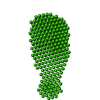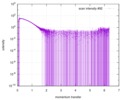+Search query
-Structure paper
| Title | A flexible multidomain structure drives the function of the urokinase-type plasminogen activator receptor (uPAR). |
|---|---|
| Journal, issue, pages | J Biol Chem, Vol. 287, Issue 41, Page 34304-34315, Year 2012 |
| Publish date | Oct 5, 2012 |
 Authors Authors | Haydyn D T Mertens / Magnus Kjaergaard / Simon Mysling / Henrik Gårdsvoll / Thomas J D Jørgensen / Dmitri I Svergun / Michael Ploug /  |
| PubMed Abstract | The urokinase-type plasminogen activator receptor (uPAR) provides a rendezvous between proteolytic degradation of the extracellular matrix and integrin-mediated adhesion to vitronectin. These ...The urokinase-type plasminogen activator receptor (uPAR) provides a rendezvous between proteolytic degradation of the extracellular matrix and integrin-mediated adhesion to vitronectin. These processes are, however, tightly linked because the high affinity binding of urokinase regulates the binding of uPAR to matrix-embedded vitronectin. Although crystal structures exist to define the corresponding static bi- and trimolecular receptor complexes, it is evident that the dynamic property of uPAR plays a decisive role in its function. In the present study, we combine small angle x-ray scattering, hydrogen-deuterium exchange, and surface plasmon resonance to develop a structural model describing the allosteric regulation of uPAR. We show that the flexibility of its N-terminal domain provides the key for understanding this allosteric mechanism. Importantly, our model has direct implications for understanding uPAR-assisted cell adhesion and migration as well as for translational research, including targeted intervention therapy and non-invasive tumor imaging in vivo. |
 External links External links |  J Biol Chem / J Biol Chem /  PubMed:22896701 / PubMed:22896701 /  PubMed Central PubMed Central |
| Methods | SAS (X-ray synchrotron) |
| Structure data |  SASDAT4:  SASDAU4:  SASDAV4: uPAR wild-type AE105 complex (Urokinase plasminogen activator surface receptor, uPAR + synthetic peptide AE105, AE105)  SASDAW4: uPAR wild-type AE234 complex (Urokinase plasminogen activator surface receptor, uPAR + synthetic peptide AE234, AE234)  SASDAX4: uPAR wild-type ATF complex (Urokinase plasminogen activator surface receptor, uPAR + Urokinase-type plasminogen activator, ATF) |
| Source |
|
 Movie
Movie Controller
Controller Structure viewers
Structure viewers About Yorodumi Papers
About Yorodumi Papers



 Homo sapiens (human)
Homo sapiens (human)